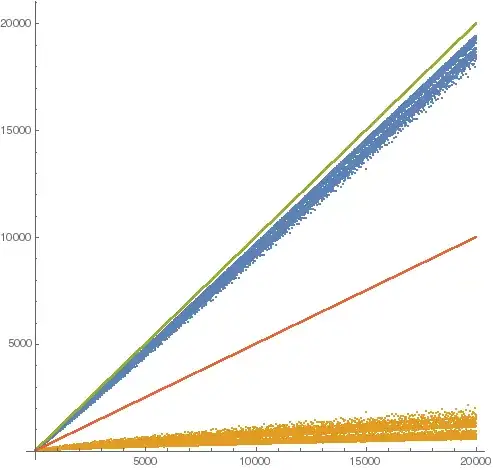I have plotted the counts of Goldbach $2n$ sums of primes, below. It is easy to see that the counts of composites gradually decreases relative to $n$ and would like a suggestion on how to prove something like this.
We use $n$ as the index to the odd numbers, $2n-1,$ on the odd-number-line (A101264) output by the Sieve of Eratosthenes with composites (and unity) set to $0$ and primes set to $1.$ We use this output to construct the mirror-symmetric $n \times n$ squares. The primary anti-diagonal of each square is the $n^\text{th}$ anti-diagonal $$\text{Ziec}(n)\text{ := } \sum _{m=1}^n (2-\delta _{0,\text{A101264}(n-m+1)})\ \delta _{0,\text{A101264}(m)}, $$ where Kronecker $\delta_{(\cdot,\cdot)}$ counts non-primes. It counts only zeros---as a one for each pair of zeros which intersect the anti-diagonal and as a two for each zero which intersects a prime. This count is equal to the count of zeros in the mirror-symmetric pattern: A101264 AND reverse(A101264) for $n=7$ (say), $\{0,1,1,1,0,1,1\}$ AND $\{1,1,0,1,1,1,0\} = \{0,1,0,1,0,1,0\}$, which is the $7^\text{th}$ anti-diagonal, with the 1's representing $3+11$, $7+7$, $11+3$, respectively.
Then the difference $n-\text{Ziec}(n)$ is the count of the $2n$ sums of two primes.
We construct a mirror-symmetric plot, with $n=20000,$ to illustrate the relationships:

Green is $n,$ blue is $\text{Ziec}(n),$ red is $n/2,$ and gold is $n-\text{Ziec}(n).$ The mirror-symmetry about the $n/2$ line is on the vertical.
EDIT 3/3/20 additional bounds For $n\geq3,\ n-\text{Ziec}(n)\geq\lfloor\sqrt{\frac{n}{2}}\rfloor$ is lower bound of gold and $\text{Ziec}(n)\leq n-\lfloor\sqrt{\frac{n}{2}}\rfloor$ is upper bound of blue.
ListPlot. – Fred Daniel Kline Mar 01 '20 at 04:35